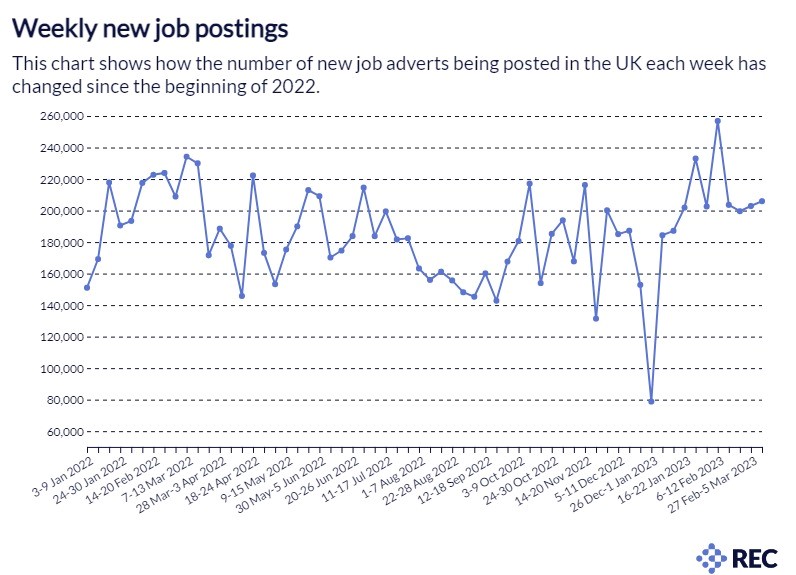- There were 205,947 new job postings in the week of 6-12 Mar 2023 – 1.5% higher compared to the week before (27 Feb-5 Mar).
- The number of active postings in the week of 6-12 Mar is 1,447,095 – a 5% increase compared to the previous week (30 Jan-5 Feb). The figure has remained around or above 1.4 million since January 2022, indicating stability in the market.
- Notable increases in adverts for jobs in the education and construction sectors, including clergy (+17.6%), plasterers (+13.6%), secondary education teaching professionals (+12.6%), production managers and directors in construction (+11.7%), and scaffolders, stagers and riggers (+11.5%).
- Three out of the UK’s top ten hiring hotspots in the week of 6-12 Mar were in London: Lambeth (+12.8%), Redbridge and Waltham Forest (+9.9%), Lewisham and Southwark (+9.8%).
- Three out of the UK’s bottom ten hiring hotspots in the week of 6-12 Mar were in Wales: Bridgend and Neath Port Talbot (+0.5%), Monmouthshire and Newport (+0.3%), Powys (-0.3%).
There were 205,947 new job postings in the week of 6-12 Mar 2023 – 1.5% higher compared to the week before (27 Feb-5 Mar), according to the Recruitment & Employment Confederation (REC) and Lightcast’s latest Labour Market Tracker.
There has been a 5% increase in the number of active postings in the week of 6-12 Mar compared to the previous week, with 1,447,095 active job adverts. The figure has remained stable around and above 1.4 million since January 2022, reflecting the high demand from employers.
Neil Carberry, Chief Executive of the REC, said:
“This new job ads data shows stability in employer demand for staff. The labour market is not surging, as it did for much of 2022, but it remains a good time to be looking for a job. Firms still need to hire and there are plenty of opportunities out there.
“There is nothing in this data that suggests that labour and skills shortages are going away soon, so companies need to adapt their hiring plans to match that. A focus on reaching into different communities, skill development and staff engagement is likely to pay off. Across the country, the best firms are working with their recruiters on this.
“There is much the Government can do, too. The Budget started to focus in the right areas on childcare and support to work, but there is a lot to do if these plans are to really make a difference. And the Budget got an F from business on skills – the current system in England actively discourages employer investment and it needs to change.
“A double-digit percentage rise in the past few weeks to nearly 40,000 nursery, primary and secondary job vacancies shows the scale of the issues with pay, workload and conditions of service among teachers. Schools are increasingly struggling to hire as the impact of several years of below-target initial recruitment plays out.”
Elena Magrini, Head of Global Research, Lightcast, said:
“The number of new online postings has stabilised in recent weeks. Compared to the fast growth seen in 2021 and the first half of 2022, the line is flattening. This shows that recruitment activity is no longer growing, which could be an early indication of the labour market cooling. However, the fact that the market is cooling and not declining in times of such uncertainty and high inflation suggests that the current economic outlook has not yet impacted negatively recruitment activity.”
Occupations with notable increases in job adverts in the week of 6-12 Mar 2023 include clergy (+17.6%), plasterers (+13.6%), financial and accounting technicians (+12.9%), archivists and curators (+12.6%), secondary education teaching professionals (+12.6%), production managers and directors in construction (+11.7%), and scaffolders, stagers and riggers (+11.5%).
On the other hand, postal workers, mail sorters, messengers and couriers (-12.3%), roundspersons and van salespersons (-6.2%), precision instrument makers and repairer (-0.2%), telecommunications engineers (+0.1%), and dental nurses (+0.4%) saw the biggest weekly decline or slowest growth in job adverts.
On regions, Gwynedd (+13%), Lambeth (+12.8%), Berkshire (+11%), Highland (+11%), and Belfast (+10.5%) saw notable increases in job adverts.
At the other end of the scale, North Lanarkshire (-8.8%) saw the largest decline in job adverts, followed by Torbay (-2.7%), Isle of Wight (-1.7%), Northumberland (-1.5%), and Inverclyde, East Renfrewshire and Renfrewshire (-1.4%).







